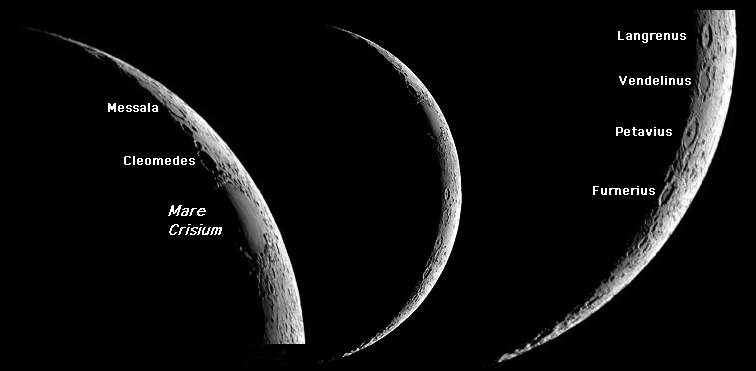Difference between revisions of "January 23, 2004"
(Created page with "__NOTOC__ =Infant Moon= ---- ===COMMENTS?=== Click on this icon image:PostIcon.jpg at the upper right to post a comment.") |
|||
| (12 intermediate revisions by the same user not shown) | |||
| Line 1: | Line 1: | ||
__NOTOC__ | __NOTOC__ | ||
=Infant Moon= | =Infant Moon= | ||
| − | + | <!-- Start of content --> | |
| − | + | <table width="85%" border="0" align="center" cellpadding="6" cellspacing="2"> | |
| − | + | <tr> | |
| − | ---- | + | </tr> |
| − | === | + | </table> |
| − | + | <table width="85%" border="0" align="center" cellpadding="6" cellspacing="2"> | |
| + | <tr> | ||
| + | <td colspan="2"><div align="center"> | ||
| + | [[File:LPOD-2004-01-23.jpeg|LPOD-2004-01-23.jpeg]]</div></td> | ||
| + | </tr> | ||
| + | </table> | ||
| + | <table width="100%" border="0" cellpadding="8"> | ||
| + | <tr> | ||
| + | <td><div align="center"><p>Image Credit: [mailto:bethomast@hexi.com Tom Talbott]</p></div></td> | ||
| + | </tr> | ||
| + | </table> | ||
| + | <table class="story" border="0" bgcolor="#FFFFFF" width="90%" cellpadding="10" align="center"><tr><td> | ||
| + | <p class="story" align="center"><b>Infant Moon</b></p> | ||
| + | <p class="story" align="left">Look west tonight, when the twilight glow is lingering, for the slender crescent of the 2-day old Moon. This is always a | ||
| + | wonderful and frustrating time to observe. Against a pinkish-blue sky, the Moon is yellow, and within its shadow you can | ||
| + | see a ghostly version of the landscapes to become visible over the next two weeks. But because the Moon is low in the sky, | ||
| + | the seeing may be fitful and the Moon seems to move faster than when it's high. During this infant Moon phase, Mare | ||
| + | Crisium is the easiest feature to identify, and often a fragmentary arc of its rim extends into the night as island peaks. | ||
| + | To the south, four large craters hug the terminator, two deep and peakful, and two shallow and flat. Have your telescope | ||
| + | or binoculars ready to go, to enjoy this view before the sliver slips under the horizon. | ||
| + | </p> | ||
| + | <p class="story"><b>Related Links:</b><br> | ||
| + | [http://www.blarg.net/~thomast/astro/moonphases.html Tom's Moon Phases]</p> | ||
| + | <p><b>Yesterday's LPOD:</b> [[January 22, 2004|Ring Around the Moon]] </p> | ||
| + | <p><b>Tomorrow's LPOD:</b> [[January 24, 2004|Platonic Nirvana]] </p> | ||
| + | </table> | ||
| + | <!-- start bottom --> | ||
| + | <table width="100%" border="0" cellspacing="2" cellpadding="4"> | ||
| + | <tr> | ||
| + | <td><hr></td> | ||
| + | </tr> | ||
| + | <tr> | ||
| + | <td><p align="center" class="main_titles"><b>Author & Editor:</b><br> | ||
| + | [mailto:tychocrater@yahoo.com Charles A. Wood]</p> | ||
| + | <!-- Cleanup of credits --> | ||
| + | <!-- Cleanup of credits --> | ||
| + | <!-- Cleanup of credits --> | ||
| + | <!-- Cleanup of credits --> | ||
| + | <!-- Cleanup of credits --> | ||
| + | <!-- Cleanup of credits --> | ||
| + | <!-- Cleanup of credits --> | ||
| + | </tr> | ||
| + | </table> | ||
| + | <!-- end cal --> | ||
| + | <div align="center"></div> | ||
| + | <p> </p> | ||
| + | <!-- End of content --> | ||
| + | {{wiki/ArticleFooter}} | ||
Latest revision as of 13:59, 15 March 2015
Infant Moon
Image Credit: Tom Talbott |
|
Infant Moon Look west tonight, when the twilight glow is lingering, for the slender crescent of the 2-day old Moon. This is always a wonderful and frustrating time to observe. Against a pinkish-blue sky, the Moon is yellow, and within its shadow you can see a ghostly version of the landscapes to become visible over the next two weeks. But because the Moon is low in the sky, the seeing may be fitful and the Moon seems to move faster than when it's high. During this infant Moon phase, Mare Crisium is the easiest feature to identify, and often a fragmentary arc of its rim extends into the night as island peaks. To the south, four large craters hug the terminator, two deep and peakful, and two shallow and flat. Have your telescope or binoculars ready to go, to enjoy this view before the sliver slips under the horizon. Related Links: Yesterday's LPOD: Ring Around the Moon Tomorrow's LPOD: Platonic Nirvana |
Author & Editor: |
COMMENTS?
Register, Log in, and join in the comments.




